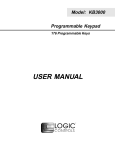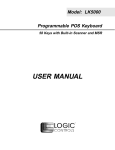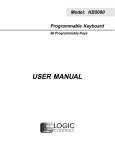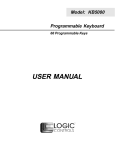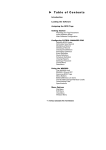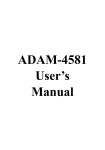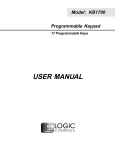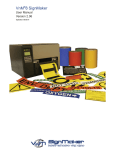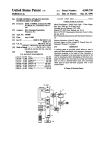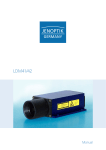Download USER MANUAL
Transcript
Model: KB3000 Programmable Keypad 176 Programmable Keys USER MANUAL NOTICE The manufacturer of the POS cash drawer makes no representations or warranties, either expressed or implied, by or with respect to anything in this manual, and shall not be liable for any implied warranties of fitness for a particular purpose or for any indirect, special or consequential damages. Information in this document is subject to change without notice and does not represent a commitment on the part of the manufacturer. FCC NOTICE This equipment generates, uses, and can radiate radio frequency energy and if not installed and used in accordance with this manual, may cause interference to radio communications. It has been tested and found to comply with the limits for a Class A digital device pursuant to Subpart J of Part 15 of FCC Rules, which are designed to provide reasonable protection against interference when operated in a commercial environment. Operation of this equipment in a residential area is likely to cause interference in which case the user at his own expense will be required to take whatever measures may be required to correct the interference. LOGIC CONTROLS, INC. 355 Denton Ave New Hyde Park, NY 11040 TEL: (516) 248-0400 FAX: (516) 248-0443 Email: [email protected] http://www.logiccontrols.com i TABLE OF CONTENTS FEATURES ............................................................................... 1 CARTON CONTENTS .............................................................. 2 HARDWARE CONNECTIONS ................................................. 3 FUNCTIONAL TEST ................................................................ 5 UTILITY DISK CONTENTS ...................................................... 6 INSTALLING THE KB3000.EXE UTILITY PROGRAM ............. 7 STARTING THE KB3000.EXE PROGRAM .............................. 7 PROGRAMMING THE KB3000 KEYPAD ................................. 9 ADVANCED PROGRAMMING ................................................. 10 SPECIAL FEATURES OF THE KB3000 ................................... 12 INTER-STRING DELAY ............................................ 12 MULTI-LEVEL DEFINITION ...................................... 12 SELF PROGRAMMING ............................................ 15 SPECIAL CONFIGURATIONS ................................................. 16 DATA TRANSFER MENU ......................................................... 18 KB3000 SPECIFICATIONS ...................................................... 20 ii FEATURES • Unmembrane keypad. • Enclosed in a heavy duty steel uni-chassis case. • Uses stainless steel dome disk switches to provide over 1 million tactile key • • • • • • • • • • • • • • • • cycles. Requires no TSR programs and thus avoids software crashes. Requires no expensive programming kits. Requires no battery. Holds data over 100 years. Multi-level key definition. Programmable inter-string delay. Self programmable with a single key stroke. 176 programmable keys with standard spacing of 0.75” between-keys. Records and plays back up to 120 alphanumeric characters per key. Provides true keyboard wedge function that operates with or without the normal computer keyboard connected. Provides optional output formats: Standard keyboard emulation (KB3000), or RS232 (KB3000-R9). Supports the following character sets: · all alphanumeric characters · 12 function keys · all IBM keyboard’s special keys (Shift, CTRL, Alt, ESC, etc.) · 255 ASCII codes Permits simple field programmability. Downloads an entire 176 key template into the internal non-volatile memory in just 7 seconds. Includes erasable and replaceable legend sheet. Built with spill-proof construction. Includes cable, legend sheet, and utility software. (XT, AT, PS/2 are registered trademarks of International Business Machines Corporation.) 1 CARTON CONTENTS KB3000 1. 2. 3. 4. 5. 6. POS keyboard, Model KB3000 Interface cable Utility software disk Reusable legend sheet (inserted under the keypad cover sheet) IBM 101 type legend sheet User’s manual KB3000-R9 1. 2. 3. 4. 5. 6. POS keyboard, Model KB3000-R9 Interface cable RS232C Interface cable Utility software disk Reusable legend sheet (inserted under the keypad cover sheet) IBM 101 type legend sheet 2 HARDWARE CONNECTIONS The KB3000 can be connected to an IBM101 PC, XT, AT or clone computer, PS/2 computer, or computer terminal. The following diagram shows how the KB3000 connects to the computer and standard keyboard or other keyboard peripheral (magnetic stripe reader, scanner, etc.). When the KB3000 is used in a stand alone configuration then no connections are made to J5. To computer keyboard port NOTE: To computer keyboard or other keyboard wedge devices Before making any connections it is always advisable to turn off the computer. A. Connecting the KB3000 to an IBM101 PC, XT, AT, or Clone computer’s keyboard port: 1. Use the supplied interface cable. Plug the 6-pin connector into J2 of the KB3000. Plug the 5-pin connector into the computer’s keyboard port. 2. Connect the computer’s keyboard into J5 of the KB3000. NOTE: J1 and J6 are not used in this configuration. 3 B. Connecting the KB3000 to a PS/2 computer: 1. Use the supplied interface cable. Plug in the 6-pin DIN connector of the interfacecable into J2 of the KB3000. 2. Connect the 5 pin DIN connector of the interface cable into the 5 pin DIN of the AT-to-PS/2 adapter. 3. Plug the PS/2 connector of the adapter into the computer’s key board port. 4. Connect the PS/2 keyboard into J1 of the KB3000. NOTE 1: J5 and J6 are not used in this configuration. NOTE 2: The AT-to-PS/2 adapter is not supplied but can be ordered from the manufacturer. C. Connecting the KB3001-R9 to a computer terminal: 1. Connect J6 of the KB3001-R9 to a RS232 port of the computer terminal using the RS232C interface cable supplied. NOTE 1: J1, J2, and J5 are not used in this configuration. NOTE 2: A different utility program comes with all KB3001-R9 keypads. An RS232C interface cable is included with all KB3001 keypads. NOTE 3: Programming the KB3001-R9 must be done on a PC computer. When programming is completed, remove the cable going to J6 and install the RS232C interface cable. NOTE 4: Before writing the file to the keypad open the F3 menu and set the RS232C option to YES. Make any changes necessary to the communications protocol setup. 4 FUNCTIONAL TEST For testing purposes, your KB3000 keypad was pre-programmed with the template shown at the right. The following simple steps will verify that the KB3000 is in good working condition: 1. Follow the Hardware Connections procedure described earlier in this manual to connect the KB3000 to your computer. 2. Turn on your computer. 3. Press the upper left corner key of the keypad (intersection of Row 1 and Column A). 4. The keypad is working correctly when the words “LOGIC CONTROLS PROGRAMMABLE KEYPAD, MODEL KB3000” appears on the monitor. NOTE: To verify if a KB3001 is working it will be necessary to use a communications program. Set the protocol to 9600 baud, no parity, and 8 data bits. Repeat steps 3 and 4 above to verify KB3001 is working correctly. 5 UTILITY DISK CONTENTS The KB3000 keypad comes with a utility software disk. This disk contains several important files: KB3D.EXE - Use this utility with or without the keypad being attached. It is used to program the keypad. For a complete description of how this program works see the section “Programming the KB3000,KB3001 keypad”. IBM101.TPL - This template was pre-programmed into the keypad and matches the legend sheet supplied with the keypad. If there are questions on how to enter a particular key you can refer back to this template to see how it was originally programmed. DL3.COM - This utility program allows you to download a stored template without entering the KB3000.EXE utility program. Simply add the KB3 directory to the path statement of the autoexec.bat file. When you want to change the stored program simply type thedownload command plus the file you want to write into the keypad. For example, to download a file called lunch, you would type DL LUNCH.TPL and press ENTER. The download program will take approximately 7 seconds to over-write the existing file and install the lunch file. KEY2TPL.EXE - This utility program converts any .KEY file (from earlier version keypads) to .TPL file. It is recommended to copy any .KEY files you may have into the KB3 directory before you start the conversion process. When you are finished you will have both .KEY and .TPL files in the KB3 directory. README.DOC - This document contains the latest information which may not be included in the manual. 6 INSTALLING THE KB3D.EXE UTILITY PROGRAM The first step in using the KB3D.EXE utility program is to copy the program to your hard drive. 1. Insert the KB3000 utility software into drive A or B. 2. Type MD KB3 at the “C>“ prompt to make a directory named KB3. 3. Type CD KB3 to make the KB3 directory active. 4. Type COPY A:*.* If the disk was inserted into drive A then all files will be copied into the hard drive’s directory (KB3). If drive B is used then you must type COPY B:*.* STARTING THE KB3D.EXE PROGRAM This program can be used with or without the keypad being attached to the computer. Note that the PC must be booted up in DOS before starting the program. It will not run properly under Windows DOS prompt. If the Windows version do not provide option to boot up computer in DOS, a DOS boot up diskette created from another computer will be required to boot up the computer. Refer to Windows user manuals for further details. To start the program, type KB3D and press ENTER. When the program is up, it will automatically display the graphic screen on next page. 7 Programming with the keypad not connected The utility can be used to do prepare tempates with the keypad not connected. The template can be saved into a file for later use. F10 File F2 File Alt + D Delay A B C D E F G H I J K L M N O P Q R S T U V + S Separator 1 + C Caps Lock Unmodified 2 * 3 4 * Modified 5 6 Shi 7 8 Left A1 A2 A3 A4 A5 A6 A7 A8 Alt + Ctrl + F4 Extende NOTE: The KB3000.EXE utility can be used to program any keypad manufactured by Logic Controls. There will be different programming graphics for each type of keypad or keyboard. 8 PROGRAMMING THE KB3000, KB3001 KEYPAD The following procedure will show you how to program the KB3000 with standard (keyboard) alphanumeric characters. The keypad can be programmed with either ASCII or Scan code information. The default mode is the ASCII code mode. The following procedure assumes a keypad and a 101 keyboard are attached. 1. With the correct programming graphics present. Select the cell you want to program by using the arrow keys on the keyboard. The Up and Down arrows will select the row while the Shift plus either the Right or Left arrow key will select the column. 2. Enter your programming text. Continue programming until all the keys are programmed. It is not necessary to program all the keys for the KB3000 to function properly. The maximum number of al phanumeric characters that can be programmed for any one key is 120. NOTE: The maximum number of alphanumeric characters that can be programmed per keypad is 1856 DATA TRANSFER MENU 3. Press F2 to call up the Data Transfer Menu. There will be several choices to choose from. 4. Type W to write the programmed data into the KB3000’s non-volatile memory. A “Data Wrote” screen will open showing the percentage of memory written. The program will be written into the keypad within 7 seconds. Dos shell File list (*.tpl) Load file from disk Read from keypad Save file to disk Write to keypad Press ESC to Quit 5. Type S to save the programmed data into the KB3 directory. You can select up to an 8 character name. It will be saved with a .TPL extension. 6. Press ESC to terminate the Data Transfer Menu. 7. Press F10 followed by Y to exit the utility program. 8. To verify that your program has been successfully installed, simply press any programmed key. The information stored in that key will appear on the monitor. 9 ADVANCED PROGRAMMING Your KB3000 POS keypad can be programmed with all special control and function keys such as the Shift, Ctrl, Alt, F1 through F12, and the up/ down/left/right arrow keys. The procedure to program these special keys is shown below: 1. Start the KB3000 utility program. 2. Press Ctrl, Alt, and F4 keys together to bring out the extended menu screen of the KB3 program. All special keys must be programmed in the SCAN code mode. 3. Select the cell to be programmed. Press F8 to enter the scancode mode. The “code type” information changes from ASCII to SCAN and +C Caps Lock changes to +A Shift Func. NOTE: The scan-code mode will only be active for this cell. You must select F8 for each cell you want to program with scan-code information. 4. Under the scan-code mode, each alphanumeric character is enclosed in parenthesis. For special function or control keys, press ESC (three vertical bars will be present) followed by the special function or control key you want to program. For example, to program the INS (insert) key, press ESC and then INS. To program the ESC key, simply press the ESC key twice. Special and control keys will not appear inside parenthesis. The three vertical bars will disappear once the special function key is depressed. 5. You may return to the start up graphic screen (short menu) by pressing Ctrl-Alt-F4 again. 10 NOTES: * Special function keys require ESC as the leading code. In the scancode mode, you can view the symbol of the special key or the hex code equivalent of the special key. To view, simply press F7 to toggle between symbol and hex modes. * Any given programmable location may be toggled between scan-code mode and ASCII-code mode. Pressing the F8 key on the keyboard will change the cell’s mode to scan-code mode. Pressing F9 on the keyboard will change the cell’s mode to ASCII-code mode. Changing modes in a cell that has been previously programmed will erase all the information in that cell. * The complete standard 101 keyboard was duplicated on the KB3000 in the template file IBM101.TPL. If you have any problems programming the KB3000 simply load the IBM101.TPL file and view the key in question to see how it should look when programmed correctly. * To enter hex scan-codes directly, press ESC followed by the 2-digit hex number. For example, to program the CTRL key press ESC followed by 1D. The KB3 program will add the leading zero. 11 SPECIAL FEATURES OF THE KB3000 Besides being able to program all keys of an IBM101 keyboard, the KB3000 has also incorporated three state-of-the-art features which will add flexibility and functionality to the keypad. INTER-STRING DELAY This feature allows for a time delay(s) to be installed after a character(s) has been inserted into a location. To use this feature follow the steps below: 1. Enter the character(s) which will precede the delay. For example, ABC. 2. Depress and hold the ALT key while pressing the letter D. A time delay screen will open asking for the amount of delay you require (up to 240 seconds). A square pixel will appear on the programming line immediately following the last character typed. 3. Type the next character(s), DEF. You can use more than one delay per location and the delay can have different times. 4. Exit the KB3 program by pressing F10 followed by the letter Y. 5. Press the location key where the time delay character has been stored. The monitor will display ABC immediately and following the delay, that you programmed, DEF will be display on the monitor. MULTI-LEVEL DEFINITION This feature can increase the apparent number of programmable keys by allowing you to program different levels into any location. For every different level you program you must select another key to be a “SHIFT LEVEL” key. Programming is accomplished in the normal manner. After programming the base level a separator bar must be entered to separate the base level from the second level. You can program more than two levels per location. For example, if you needed to program small, medium, and large coffee into one key follow the procedure outlined on the following page. 12 1. Select a blank location (A1) and enter the most common coffee first ( medium coffee). Mark the legend sheet for this location COFFEE. 2. Enter the separator bar by depressing and holding the ALT key and pressing the letter S. A solid bar will appear on the programming line immediately following the last character typed. 3. Enter the second level (small coffee) followed by another separator. 4. Enter the third level information (large coffee). The entire programming line should look like the following: A1 5. Select a blank location (A7)to become the first level shift position. Mark the legend sheet for this location SMALL. 6. Change the mode of this location to scan-code mode (F8). Depress and hold the ALT key while pressing the letter A. A triangle inside brackets (< >) will appear on the programming line. This key when depressed will activate the second level. 7. Select another blank location (A8). This will become the second level shift position (will activate the third level of information on the keys). Mark the legend sheet for this position LARGE. 8. Change the mode of this location to the scan-code mode (F8). Depress and hold the ALT key while depressing the letter A twice. Two triangles inside brackets will appear on the programming line. 9. To use this feature in your application is extremely simple. When medium coffee is desired just press the A1 key. When a small coffee is desired press and hold the A7 key while pressing the A1 key. When a large coffee is desired press and hold the A8 key while pressing the A1 key. 10. Program location A2 with large soda, medium soda, and small soda the same way as steps 1 through 4 above. When A2 is pressed you will get large soda. Depress and hold A7 while pressing A2. The medium soda will be displayed. Depress and hold A8 while pressing A2. The small soda will be displayed. NOTE: There is no preset limit to the number of levels that can be programmed into a keypad. 13 1. Select a blank location (A1) and enter the most common coffee first (medium coffee). Mark the legend sheet for this location COFFEE. 2. Enter the separator bar by depressing and holding the ALT key and pressing the letter S. A solid bar will appear on the programming line immediately following the last character typed. 3. Enter the second level (small coffee) followed by another separator. 4. Enter the third level information (large coffee). The entire programming line should look like the following: A1 MEDIUM COFFEE SMALL COFFEE LARGE COFFEE 5. Select a blank location (A7)to become the first level shift position. Mark the legend sheet for this location SMALL. 6. Change the mode of this location to scan-code mode (F8). Depress and hold the ALT key while pressing the letter A. A triangle inside brackets (< >) will appear on the programming line. This key when depressed will activate the second level. 7. Select another blank location (A8). This will become the second level shift position (will activate the third level of information on the keys). Mark the legend sheet for this position LARGE. 8. Change the mode of this location to the scan-code mode (F8). Depress and hold the ALT key while depressing the letter A twice. Two triangles inside brackets will appear on the programming line. 9. To use this feature in your application is extremely simple. When medium coffee is desired just press the A1 key. When a small coffee is desired press and hold the A7 key while pressing the A1 key. When a large coffee is desired press and hold the A8 key while pressing the A1 key. 10. Program location A2 with large soda, medium soda, and small soda the same way as steps 1 through 4 above. When A2 is pressed you will get large soda. Depress and hold A7 while pressing A2. The medium soda will be displayed. Depress and hold A8 while pressing A2. The small soda will be displayed. NOTE: There is no preset limit to the number of levels that can be programmed into a keypad. 14 SELF PROGRAMMING To use this feature the KB3 directory must be added to the path statement of the AUTOEXEC.BAT file. This feature is extremely helpful for applications where the keypad files are changing on a regular bases. A key location must be reserved in each file to perform the self programming function. 1. Select the key location to contain the self programming information (V1). 2. The information to be entered into this location will be the download command plus the name of the file to be loaded into the keypad. For example, if you want to change from a breakfast menu to a lunch menu the V1 location in the breakfast file can be programmed as follows: DL LUNCH.TPL 3. To change to the lunch menu simple press V1. The download program will load the lunch menu into the keypad. NOTE: Additional characters may have to be added to the information in V1 to first exit the application program being run. 15 SPECIAL CONFIGURATIONS The KB3000 can be set up with many different programming options. To activate the configuration menu screen the KB3 program must first be placed into the extended menu (Ctrl, Alt, F4). Press F3 to open the configuration screen. By depressing the highlighted letter in each option the program will enable or disable that option. The default settings are shown in the graphic below. Send Break-codes for scan-codes Yes Enable beep while a key pressed Yes No beep if a key is undefined Yes Translate to code-set #2 for AT Yes Emulating XT keyboard always No Use ALT+num to generate ASCII No Enable Typematic for scan codes No Enable Typematic for ASCII codes No Emulating Link Terminal No InterCharacter Delay (+/-): 2 mS Enable RS232 Output No Baud Rate: 9600 Parity: NONE Length of Data: 8 -bits Press a High-light Letter to select Esc ==> Quit from this menu 16 Send Break-code for scan-codes - Enables or disables the transmission of break codes for each scan code programmed into the keyboard. Enable beep while a key pressed - Enables or disables the entire keyboard from beeping when any key is depressed. No beep if a key is undefined - If a key is not programmed it will not beep when depressed. Translate to code set #2 for AT - Enables or disables the output of the keyboard to be translated into AT scan code. Emulating XT keyboard always - Enables or disables the output of the keyboard to be translated into XT scan code. Use ALT +num to generate ASCII - Enables or disables the ability to use the ALT key along with the numeric keyboard to generate ASCII codes. Enable typematic for scan codes - Enables or disables keys programmed with scan code information to repeat the programmed characters as long as the key remains depressed. Enable typematic for ASCII codes - Enables or disables keys programmed with ASCII code information to repeat the programmed characters as long as the key remains depressed. Emulating Link Terminal - Enables or disables the keyboards ability to emulate a link terminal. Intercharacter Delay (+/-) - The time delay between characters can be adjusted from 1 millisecond to 266 milliseconds. This delay is set for all characters programmed into the keyboard. Do not confuse this feature with the inter-string delay feature. 17 Enable RS232 Output - Enables or disables the output of the keyboard to the RS232 port (DB9 connector). If this option is set to YES then the protocol settings must be set to mirror the application software. Baud Rate - This option selects 2400, 4800, 9600 and 19,200 baud rates. Parity - This option selects ODD, EVEN or NO parity. Length of data - This option selects either 7 or 8 data bits. DATA TRANSFER MENU Save COMPUTER'S RAM MEMORY Load Write Read COMPUTER'S HARD DISK KB3000 KEYPAD 18 Dos shell File list (*.tpl) Load file from disk Read from keypad Save file to disk Write to keypad Press ESC to Quit The KB3000 keypad, working in conjunction with the KB3000.EXE utility software, can perform the following powerful functions: * Save programmed data as a template file (.TPL) in both the keyboard and the hard drive of the computer. To save programmed data to the keyboard use the W (Write to keyboard) option of the Data Transfer Menu. To save programmed data to the hard drive use the S (Save file to disk) option of the Data Transfer Menu. * Load (L) a previously programmed template from the hard disk into the computer’s volatile RAM memory. The same template can then be written (W) into the non-volatile memory of the KB3000. This process, as an example, allows a restaurant to change from a breakfast menu to a lunch menu within 7 seconds. * Enables the computer to read (R) a template stored in the KB3000. That template can then be saved (S) to the hard disk for future use. * Display a list of templates that have been stored onto the hard disk within the KB3 directory. From the Data Transfer Menu select F for File List. The computer’s monitor will display the list of .TPL files stored in the KB3 directory. * Interruption of the programming process to shell out to DOS (D) to perform other operations. To return to the programming process type EXIT at the DOS prompt. NOTE: Never shell out of windows to work in this utility program. 19 KB3000 SPECIFICATIONS MECHANICAL Weight Dimension ( in inches ) Width Depth Front Height Rear Height Keys Life cycle Spacing 6.0 lb. 19.0 in. (482.8 mm) 8.6 in. (218.9 mm) 0.9 in. (22.3 mm) 1.3 in. (33.77 mm) Stainless Steel Dome Disks > 1 million tactile operations Standard 0.75 inches between keys. ELECTRICAL Input Voltage (from comp.) +5VDC Current 25 ma. ENVIRONMENTAL Operating Temperature Storage Temperature Relative Humidity Operating Non-operating Vibration ( 10 to 55 Hz. ) Shock 85% max., non-condensing 90% max., non-condensing 4G’s 40G’s INTERFACES Keyboard emulation RS232C ( KB3001 ) Baud Rate Parity Data Bit 9600 None 8 0 to +50oC -20 to +70oC Standard 20 CONNECTOR PINOUTS J1 (PS/2F) to PS/2 Keyboard 1 Keyboard Data 2 No Connection 3 Ground 4 +5VDC 5 Clock 6 No Connection J2 (DIN 6F) to Computer * 1 Clock 2 CPU Data 3 No Connection 4 Ground 5 +5VDC 6 No Connection * Requires an AT to PS/2 adapter to work with PS/2 computer. 1 6 2 J5 (DIN 5F) to 101 Keyboard 1 Keyboard Clock 2 Data 3 No Connection 4 Ground 5 +5VDC J6 (DB9F) RS232C 1 DCD 2 Receive Data from computer 3 Transmit Data to computer 4 DTR 5 Ground 6 DSR 7 RTS 8 CTS 9 No Connection Pins 1,4, and 6 are tied together internally Pins 7 and 8 are tied together internally 21 5 4 3


























